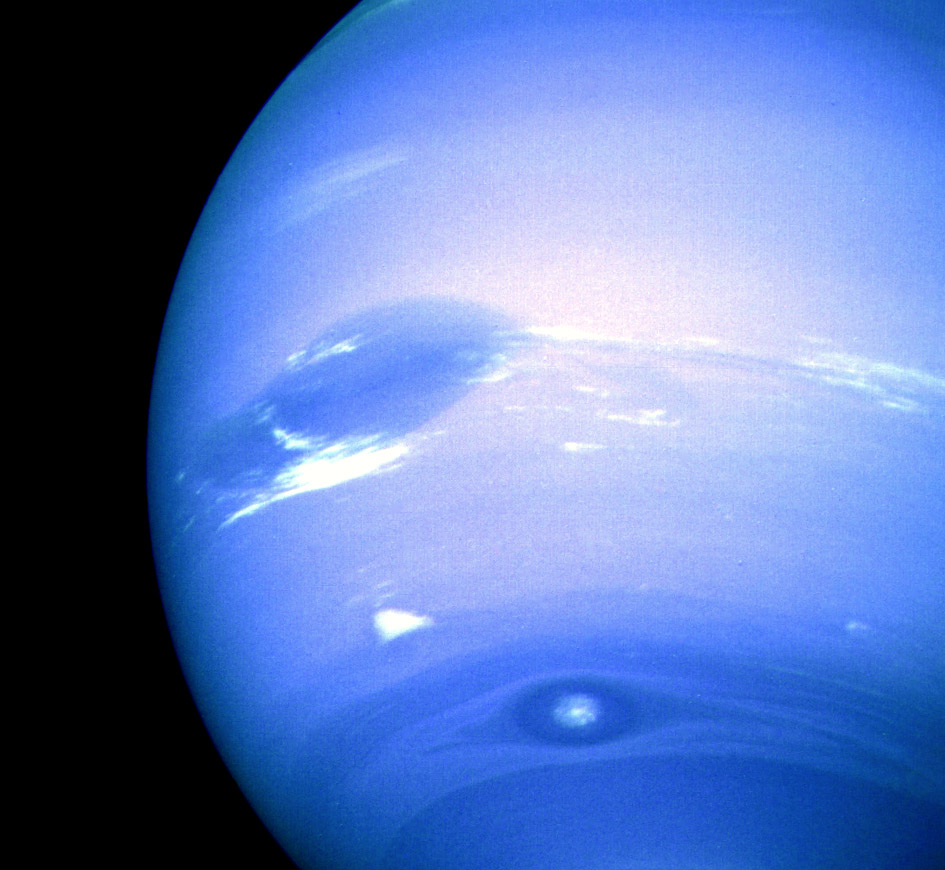
NEPTUNE
Vital Stats:
-
Orbital radius: 30 Earth's
-
Diameter: 4 Earth's
-
Mass: 17 Earth's
-
Gravity: 1.1 g
-
Year: 165 Earth's
-
Day: 15 hours
Points of Interest:
-
Neptune and Uranus are "twins," being about the same mass and density. Earth and Venus are similar twins. Is there some mechanism that encourages the creation of twin planets?
-
Neptune has such low density, its gravity is barely higher than Earth's.
-
The density is higher than Jupiter's or Saturn's, though, so Neptune is presumably not just a ball of hydrogen and helium, like the two giants. Lots of methane, perhaps.
-
Most planets give off more heat than they get from the Sun, but Neptune gives off even more than Jupiter does. No one knows why.
-
Neptune is an almost featureless ball of blue, though it does develop belts like those of Jupiter and Saturn, at certain seasons of its long year.
-
Just as Jupiter has its Great Red Spot, Neptune has a Great Dark Spot. There's also a Small Dark Spot. They come and go, and are just as mysterious as the markings on the other gas giants.
-
The prevailing winds on Neptune blow opposite the direction of rotation. No one knows why.
-
Neptune's "rings" are so slight, they are really more arcs than rings.
-
Neptune has one big moon, Triton, and lots of little ones.
-
Triton orbits Neptune "backwards," opposite the direction of Neptune's rotation. It's the only major moon in the Solar System to do this.
-
Triton may not have formed with Neptune, but have been captured, taking out any other large Neptunian moons in the process.
-
Triton is a pretty spectacular moon, having ice caps and water volcanos, and being about as big as Pluto.
Neptune on Earth:
From his records, we know that Galileo actually saw Neptune in his telescope a couple of times, but on both occasions he mistook it for a dim star, so that doesn't count.
The instrument used to discover Neptune was not the telescope but the planet Uranus.
It was
Alexis Bouvard, in 1821, who first deduced the existence of Neptune from some irregularities in the orbit of Uranus, just as Uranus had been hinted at by perturbations in the movements of Saturn. Then followed an astronomical race, between John Couch Adams of England and
Urbain Le Verrier of France to calculate the exact orbit and position of the new planet. Le Verrier won narrowly, in 1846, when French astronomers found it first, causing a certain amount of nationalistic heartburn among the British.
Le Verrier wanted to name the planet after himself, but that didn't fly any better than William Herschel's attempt to name Uranus "George's Star." "Janus" and "Oceanus" were suggested, but soon the astronomers settled on "Neptune," possibly because of the blue color.
Neptune was explored by Voyager 2 in 1989.
On to Pluto and Beyond
Back to Uranus and the Centaur Belt
Return to Gallery of Planets
Return to Introduction to Essays
Return to Wind Off the Hilltop
Copyright © Earl Wajenberg, 2012
